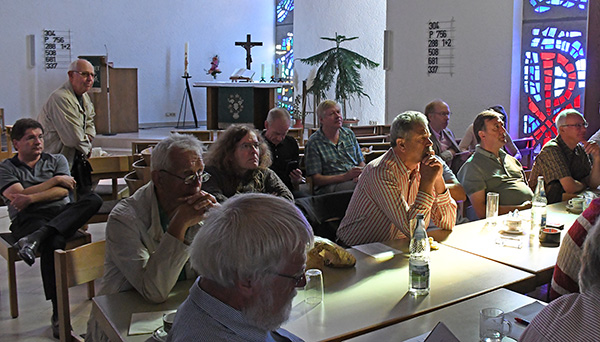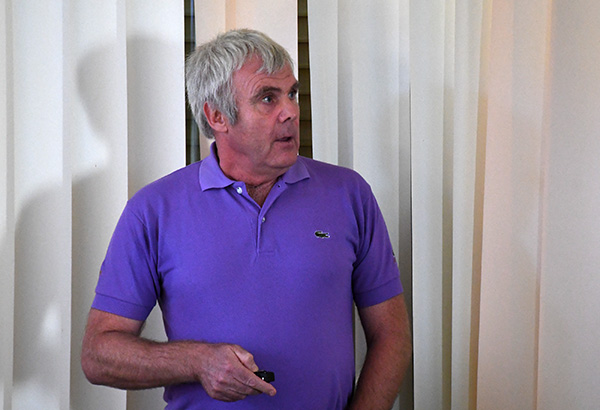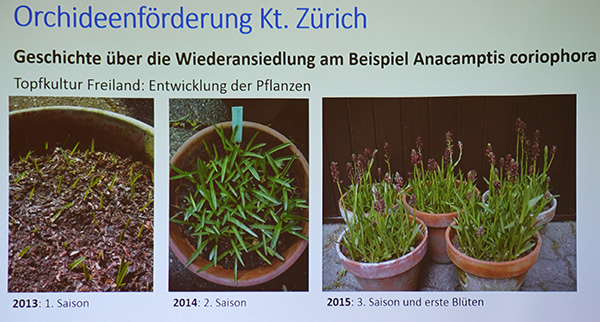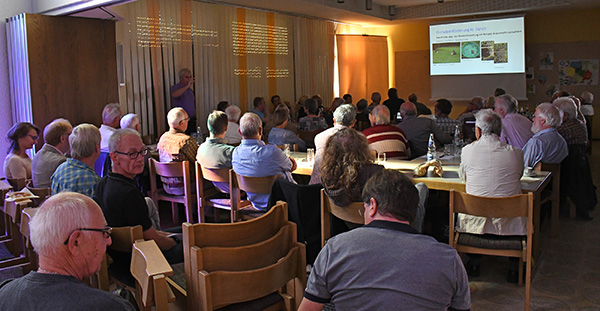 An unusual rescue mission in the canton Zurich was subject of the 2018 orchids conference in Kehl-Neumuehl, Germany. In this Swiss region, nutrient-poor grassland and bright forests have been dramatically reduced, René Gaemperle explained. Reasons are – as in other regions – the over fertilization of the intense agriculture and the increased building activity: “Where the hills are most beautiful, country residences are built”, Gaemperle said.
An unusual rescue mission in the canton Zurich was subject of the 2018 orchids conference in Kehl-Neumuehl, Germany. In this Swiss region, nutrient-poor grassland and bright forests have been dramatically reduced, René Gaemperle explained. Reasons are – as in other regions – the over fertilization of the intense agriculture and the increased building activity: “Where the hills are most beautiful, country residences are built”, Gaemperle said.
In order to strengthen weak populations like Ophrys araneola, Gaemperle cooperated with officials and organized manual pollination, collection of seeds, mixture of seeds with river sand and sowing. If the appropriate symbiosis fungus is in soil, this method works rather soon, explained Gaemperle. The time from sowing to first flowering is just three to six years.
He chose a different method with Anacamptis coriophora: Seed capsules from the Lake constance habitat Wollmatinger Ried have been sent to an expert for in vitro culture in Sweden. The young plants have then been planted at seven places in canton Zurich, overall 525 plants until 2015. In this year 56 of those plants have flowered, Gaemperle told. When species are threatened by extinction, such methods are the only way to save them. “If we don’t act now, they will vanish forever.”
Threatened orchid species are also an issue for Peter Steinfeld who lectured about the nature reservate Bliesgau in the German state of Saarland. Steinfeld has been observing the changes of the regional flora for 35 years. According to him, Cephalanthera rubra is threatened by extinction in Saarland – he found the last flowering plants in Bliesgau about 20 years ago. Heavily decreasing is also Dactylorhiza viridis. But Limodorum abortivum is expanding, probably coming from the French region of Lorraine. The same case is with Ophrys sphegodes and Orchis simia. As another “profiteer of climate change” Steinfeld named Himantoglossum hircinum. Climate change was also the subject of my lecture with impressions of this summer on Gotland, Sweden. Jean-Marc Haas also reported about dried out places in Uzbekistan.
At the conference with more than 60 participants from four countries, which was organized by Harald Baumgartner and Hubert Heitz, Helmuth Zelesny lectured about a field trip to the Golzentipp mountain in Eastern Tyrol, with colour variants of Nigritella rhellicani in white, yellow and carmine. In this region at the edges of the Lienz Dolomites Gymnadenia conopsea is also quite often white-flowered. Hybrids of both species display a big variety of forms. Not so common is the hybrid of Gymnadenia conopsea with Pseudorchis albida. Nigritella rubra is flowering on lime stone. The variety of the orchid flora on this Alpine meadows has also been described by Norbert Griebl in his paper published by AHO-Berichte.
Helmut Presser lectured about new taxons related to Ophrys holoserica and Ophrys scolopax in France as there are Ophrys demangei and Ophrys quercophila, the oak loving Ophrys. Hartmut Moeller again showed impressive photos of pollinators, this time he observed Epipactis palustris with potter wasps, bumblebees and beetles.


